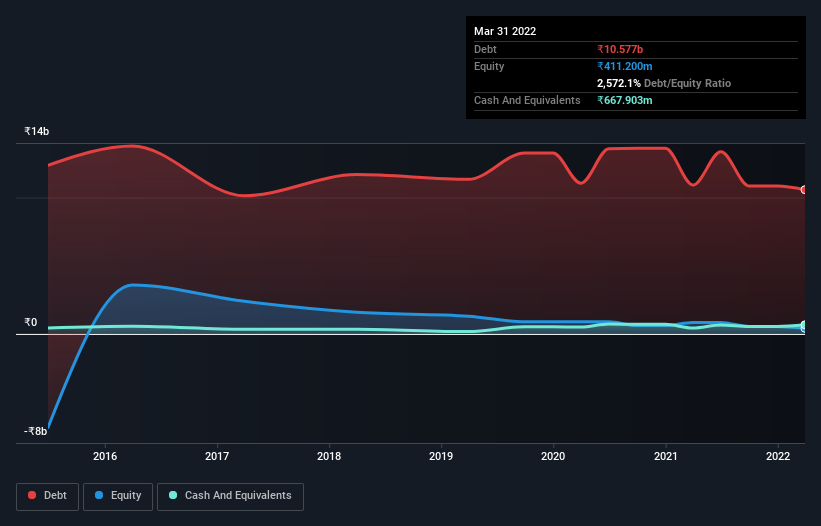Health Check: How Prudently Does Simbhaoli Sugars (NSE:SIMBHALS) Use Debt?

Howard Marks put it nicely when he said that, rather than worrying about share price volatility, 'The possibility of permanent loss is the risk I worry about... and every practical investor I know worries about.' So it might be obvious that you need to consider debt, when you think about how risky any given stock is, because too much debt can sink a company. We note that Simbhaoli Sugars Limited (NSE:SIMBHALS) does have debt on its balance sheet. But the real question is whether this debt is making the company risky.
Why Does Debt Bring Risk?
Debt is a tool to help businesses grow, but if a business is incapable of paying off its lenders, then it exists at their mercy. Part and parcel of capitalism is the process of 'creative destruction' where failed businesses are mercilessly liquidated by their bankers. While that is not too common, we often do see indebted companies permanently diluting shareholders because lenders force them to raise capital at a distressed price. Of course, the upside of debt is that it often represents cheap capital, especially when it replaces dilution in a company with the ability to reinvest at high rates of return. When we think about a company's use of debt, we first look at cash and debt together.
See our latest analysis for Simbhaoli Sugars
What Is Simbhaoli Sugars's Net Debt?
As you can see below, Simbhaoli Sugars had ₹10.6b of debt, at March 2022, which is about the same as the year before. You can click the chart for greater detail. On the flip side, it has ₹667.9m in cash leading to net debt of about ₹9.91b.

A Look At Simbhaoli Sugars' Liabilities
According to the last reported balance sheet, Simbhaoli Sugars had liabilities of ₹20.5b due within 12 months, and liabilities of ₹558.4m due beyond 12 months. On the other hand, it had cash of ₹667.9m and ₹756.3m worth of receivables due within a year. So it has liabilities totalling ₹19.7b more than its cash and near-term receivables, combined.
This deficit casts a shadow over the ₹1.08b company, like a colossus towering over mere mortals. So we'd watch its balance sheet closely, without a doubt. After all, Simbhaoli Sugars would likely require a major re-capitalisation if it had to pay its creditors today. The balance sheet is clearly the area to focus on when you are analysing debt. But it is Simbhaoli Sugars's earnings that will influence how the balance sheet holds up in the future. So when considering debt, it's definitely worth looking at the earnings trend. Click here for an interactive snapshot.
In the last year Simbhaoli Sugars had a loss before interest and tax, and actually shrunk its revenue by 9.3%, to ₹11b. That's not what we would hope to see.
Caveat Emptor
Importantly, Simbhaoli Sugars had an earnings before interest and tax (EBIT) loss over the last year. Indeed, it lost ₹78m at the EBIT level. Reflecting on this and the significant total liabilities, it's hard to know what to say about the stock because of our intense dis-affinity for it. Sure, the company might have a nice story about how they are going on to a brighter future. But the reality is that it is low on liquid assets relative to liabilities, and it lost ₹224m in the last year. So we think buying this stock is risky. The balance sheet is clearly the area to focus on when you are analysing debt. But ultimately, every company can contain risks that exist outside of the balance sheet. We've identified 2 warning signs with Simbhaoli Sugars , and understanding them should be part of your investment process.
At the end of the day, it's often better to focus on companies that are free from net debt. You can access our special list of such companies (all with a track record of profit growth). It's free.
New: Manage All Your Stock Portfolios in One Place
We've created the ultimate portfolio companion for stock investors, and it's free.
• Connect an unlimited number of Portfolios and see your total in one currency
• Be alerted to new Warning Signs or Risks via email or mobile
• Track the Fair Value of your stocks
Have feedback on this article? Concerned about the content? Get in touch with us directly. Alternatively, email editorial-team (at) simplywallst.com.
This article by Simply Wall St is general in nature. We provide commentary based on historical data and analyst forecasts only using an unbiased methodology and our articles are not intended to be financial advice. It does not constitute a recommendation to buy or sell any stock, and does not take account of your objectives, or your financial situation. We aim to bring you long-term focused analysis driven by fundamental data. Note that our analysis may not factor in the latest price-sensitive company announcements or qualitative material. Simply Wall St has no position in any stocks mentioned.
About NSEI:SIMBHALS
Good value slight.
Market Insights
Community Narratives



